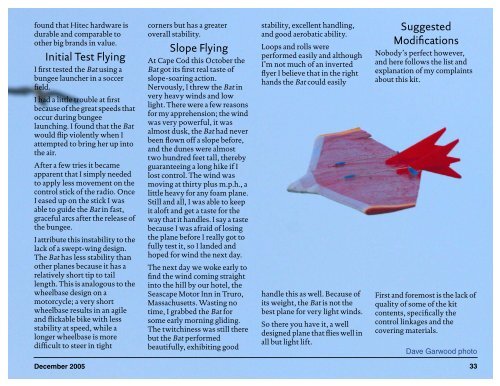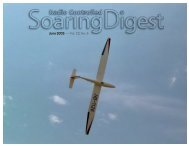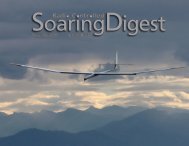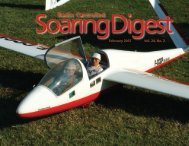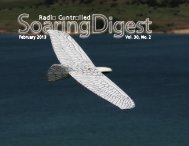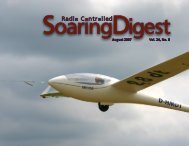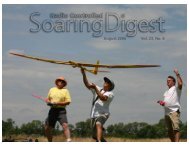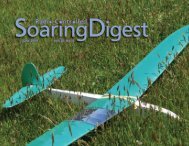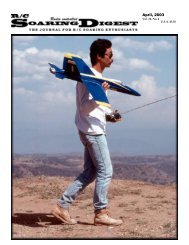December 2005 — Vol. 22, No. 12 - RC Soaring - RCSoaring.com
December 2005 — Vol. 22, No. 12 - RC Soaring - RCSoaring.com
December 2005 — Vol. 22, No. 12 - RC Soaring - RCSoaring.com
You also want an ePaper? Increase the reach of your titles
YUMPU automatically turns print PDFs into web optimized ePapers that Google loves.
found that Hitec hardware is<br />
durable and <strong>com</strong>parable to<br />
other big brands in value.<br />
Initial Test Flying<br />
I first tested the Bat using a<br />
bungee launcher in a soccer<br />
field.<br />
I had a little trouble at first<br />
because of the great speeds that<br />
occur during bungee<br />
launching. I found that the Bat<br />
would flip violently when I<br />
attempted to bring her up into<br />
the air.<br />
After a few tries it became<br />
apparent that I simply needed<br />
to apply less movement on the<br />
control stick of the radio. Once<br />
I eased up on the stick I was<br />
able to guide the Bat in fast,<br />
graceful arcs after the release of<br />
the bungee.<br />
I attribute this instability to the<br />
lack of a swept-wing design.<br />
The Bat has less stability than<br />
other planes because it has a<br />
relatively short tip to tail<br />
length. This is analogous to the<br />
wheelbase design on a<br />
motorcycle; a very short<br />
wheelbase results in an agile<br />
and flickable bike with less<br />
stability at speed, while a<br />
longer wheelbase is more<br />
difficult to steer in tight<br />
corners but has a greater<br />
overall stability.<br />
Slope Flying<br />
At Cape Cod this October the<br />
Bat got its first real taste of<br />
slope-soaring action.<br />
Nervously, I threw the Bat in<br />
very heavy winds and low<br />
light. There were a few reasons<br />
for my apprehension; the wind<br />
was very powerful, it was<br />
almost dusk, the Bat had never<br />
been flown off a slope before,<br />
and the dunes were almost<br />
two hundred feet tall, thereby<br />
guaranteeing a long hike if I<br />
lost control. The wind was<br />
moving at thirty plus m.p.h., a<br />
little heavy for any foam plane.<br />
Still and all, I was able to keep<br />
it aloft and get a taste for the<br />
way that it handles. I say a taste<br />
because I was afraid of losing<br />
the plane before I really got to<br />
fully test it, so I landed and<br />
hoped for wind the next day.<br />
The next day we woke early to<br />
find the wind <strong>com</strong>ing straight<br />
into the hill by our hotel, the<br />
Seascape Motor Inn in Truro,<br />
Massachusetts. Wasting no<br />
time, I grabbed the Bat for<br />
some early morning gliding.<br />
The twitchiness was still there<br />
but the Bat performed<br />
beautifully, exhibiting good<br />
stability, excellent handling,<br />
and good aerobatic ability.<br />
Loops and rolls were<br />
performed easily and although<br />
I’m not much of an inverted<br />
flyer I believe that in the right<br />
hands the Bat could easily<br />
handle this as well. Because of<br />
its weight, the Bat is not the<br />
best plane for very light winds.<br />
So there you have it, a well<br />
designed plane that flies well in<br />
all but light lift.<br />
Suggested<br />
Modifications<br />
<strong>No</strong>body’s perfect however,<br />
and here follows the list and<br />
explanation of my <strong>com</strong>plaints<br />
about this kit.<br />
First and foremost is the lack of<br />
quality of some of the kit<br />
contents, specifically the<br />
control linkages and the<br />
covering materials.<br />
Dave Garwood photo<br />
<strong>December</strong> <strong>2005</strong> 33


